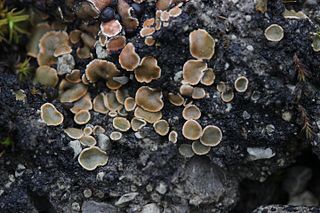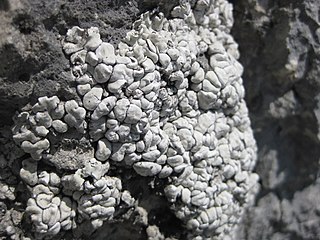
Psora is a genus of lichen-forming fungi in the family Psoraceae. Members of the genus are commonly called fishscale lichens. Lichens in the genus Psora generally have a squamulose thallus and anthraquinones in the hymenium. Photobiont partners of Psora lichens include members of the green algal genera Asterochloris, Chloroidium, Myrmecia, and Trebouxia.

The Lecideaceae are a family of lichens in the order Lecideales. It contains about 30 genera about roughly 250 species. A major distinguishing characteristic of the family is the lecanoroid form of the fruiting bodies: typically circular, dark, and without a thalline margin. Most species in the family are lichenised with green algae, although a few species, scattered amongst several genera, are lichenicolous–they live on other lichens. Lecideaceae lichens tend to grow on rocks, wood, and soil. The largest genus in the family, Lecidea, was once a loosely circumscribed wastebasket taxon containing hundreds of morphologically similar species with generally crustose thalli, photobiont-free apothecial margins and translucent, single-celled ascospores. The overall taxonomy and classification within the family has been made more accurate with recent molecular phylogenetics studies.

The Tephromelataceae are a family of lichenized fungi in the order Lecanorales. The family was circumscribed by Austrian lichenologist Josef Hafellner in 1984. Tephromelataceae comprises the genera Tephromela, Calvitimela, Mycoblastus and Violella, which together constitute a well-supported monophyletic group.

Schaereria is a genus of lichen-forming fungi. It is the sole genus in the family Schaereriaceae, which itself is the only family in the Schaereriales, an order in the subclass Ostropomycetidae of the class Lecanoromycetes. Most Schaereria species are crustose lichens that live on rocks. Schaereria was first proposed by Gustav Wilhelm Körber in 1855 and was later taken up by other lichenologists despite periods of disuse.
Bibbya is a genus of fruticose lichens in the family Ramalinaceae.

Rhizocarpales are an order of lichen-forming fungi in the subclass Lecanoromycetidae of the class Lecanoromycetes. It has two families, Rhizocarpaceae and Sporastatiaceae, which contain mostly crustose lichens.

Carbonicola is a small genus of lichen-forming fungi. It is the sole genus in the monogeneric family Carbonicolaceae. The genus, which collectively has an almost cosmopolitan distribution, contains three squamulose lichens that prefer to grow on burned wood in temperate areas of the world.

Lecidea tessellata is a species of saxicolous (rock-dwelling), crustose lichen in the family Lecideaceae. It was formally described as a species in 1819 by German botanist Heinrich Flörke. In northern North America, it is common and widely distributed, growing on non-calcareous rocks. It also occurs in Afghanistan, China, Nepal, Europe, and Russian Asia. In India, it has been recorded only from the alpine Western Himalayas at an altitude of 3,450 m (11,320 ft). Its southern distribution extends to James Ross Island, where it is locally common.

Psora altotibetica is a species of terricolous (ground-dwelling), squamulose lichen in the family Psoraceae. It occurs in the Tibetan region of China and in Nepal. The species bears a resemblance to Psora indigirkae but is genetically closer to Psora tenuifolia and Psora vallesiaca. It differs from the rest in certain features such as the colour of its apothecia, size of ascospores, and secondary chemical composition. The lichen's habitat is in the alpine zones of the Great Himalayas at altitudes between 4,230 and 5,000 m.

Thalloidima is a genus of lichen-forming fungi in the family Ramalinaceae. It has 13 species.
Lecanactis minutissima is a species of corticolous (bark-dwelling), crustose lichen in the family Roccellaceae. Found in Sri Lanka, the lichen is characterised by its pale ochraceous thallus and sessile apothecia with dark brown discs, covered with thick white granular pruina.
Fauriea trassii is a lichen species in the family Teloschistaceae, described in 2011. It is primarily found in the Far East of Russia, particularly in the Primorsky Krai region.
Lecidea lygommella is a species of saxicolous (rock-dwelling), crustose lichen in the family Lecideaceae. It spreads up to 7 cm wide with a thin thallus varying in colour from whitish and pale grey to rusty red-brown, featuring areolate surfaces with irregularly shaped areoles. Its fruiting bodies range from slightly embedded to sitting atop the thallus and black, flat to slightly convex apothecial discs. Unlike its lookalike Lecidea lygomma, L. lygommella does not produce any secondary chemicals. It is found in New South Wales and Victoria, Australia, where it grows on rocks in alpine areas.
Megalospora austropacifica is a species of corticolous (bark-dwelling), crustose lichen in the family Megalosporaceae. It is found on the islands of Taveuni and Viti Levu in Fiji. It has a yellowish grey to whitish grey, glossy thallus that is thick and may appear slightly wrinkled or smooth, often with irregular cracks and small papillae containing conidiomata, but lacking isidia and soredia. Its apothecia are circular, up to 4.5 mm in diameter, with the disc evolving from concave to slightly convex and coloured from orange-brown to red-brown, surrounded by a thick, prominent margin.
Placolecis kunmingensis is a species of saxicolous (rock-dwelling), crustose lichen in the family Catillariaceae. It is found in Yunnan, China. The lichen is characterised by a thallus that is areolate to squamulose in its centre, forming irregular patches or clumps 10–50 mm wide, as well as its ellipsoid or spherical ascospores with slightly thickened wall.
Tetramelas flindersianus is a saxicolous (rock-dwelling) crustose lichen species in the family Physciaceae. First described scientifically in 2020, it is found in Australia.
Buellia cravenii is a species of saxicolous (rock-dwelling), crustose lichen in the family Caliciaceae. It is found in Australia. The lichen spreads up to 3.5 cm wide thick, forming a continuous, grey-white cracked pattern of areoles.
Amandinea pilbarensis is a little-known species of crustose lichen in the family Physciaceae, First described in 2020, it is found in Australia. It is similar to Amandinea polyxanthonica, but can be distinguished by its smaller ascospores and the presence of calcium oxalate and thiophanic acid in the medulla.
Byssoloma xanthonicum is a species of corticolous (bark-dwelling), crustose lichen in the family Pilocarpaceae. It is found in New Caledonia.
Buellia subalbula is a species of saxicolous (rock-dwelling), crustose lichen in the family Caliciaceae. It occurs in coastal southern Africa, South America, and Australia, where it grows on calcareous rocks.









